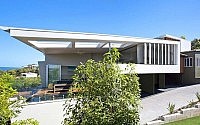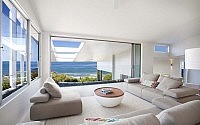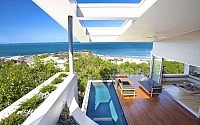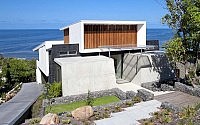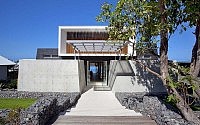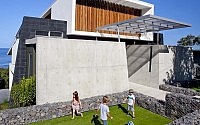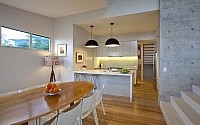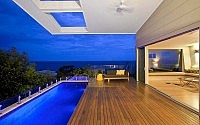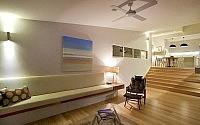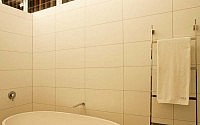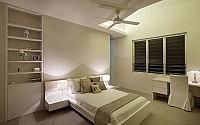Coolum Bays Beach House by Aboda Design Group
This modern three storey residence was designed by Aboda Design Group for a family with three children. The property is situated in Coolum Bays, Australia, and offers spectacular white water views.
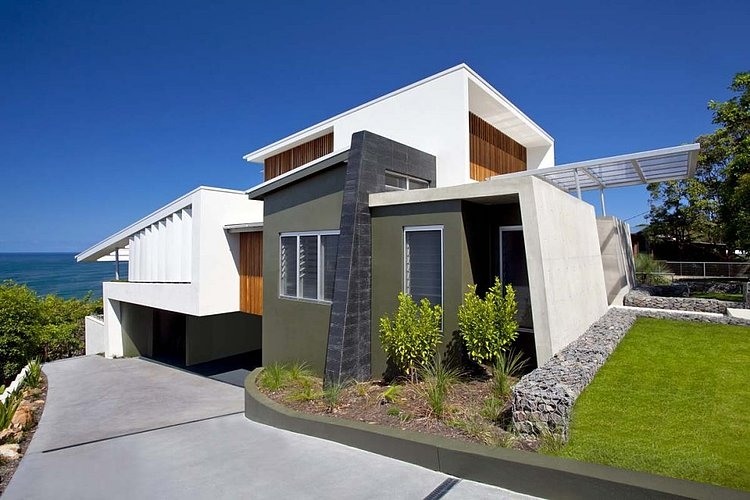
















Description by Aboda Design Group
1. Satisfaction of the Brief
As former owner of the adjoining property, the clients imperative was to accommodate a family with the three children nearing or at adulthood, which took advantage of the amazing potential for white water views from the Coolum Bays all the way to Noosa Heads. The challenge was to accommodate a maximum 1:4 compliant driveway from Fauna Terrace above, which tucked under the home to accommodate three cars (without requiring excavation of rock), with half-level accommodation above, that remained inside the Maroochy Plans 2000 steep land (>20%) planning envelope. Added to the dramatic fall from west to east was another, more gently crossfall from north to south, which also influenced the massing of the building as it spread across the site.
Early exploration of the geotechnical composition of the site, combined with a longitudinal section through the length of the driveway, determined the lower floor volumes. From there, minimum clearance heights of the Garage were determined. Simultaneously, the minimum projection eastwards, to maximise uninterrupted views to Noosa Heads, was determined by erecting a scaffold on the site, again combined by utilising the 3D modelling capability to determine the maximum allowable 10M planning envelope.
Once the site constraints were fully understood, and the building form was developed to accommodate the four ensuited bedrooms, two living areas + media room, kitchen, dining, laundry, home office, two powder rooms, workshop, pool and rainwater tank, the scheme was lodged for Relaxation approval for minor intrusion into the steep land side setback profile peculiar to the Maroochy Plan. Once approved, without condition, the scheme was finalised.
From the outset, the client (Builder) confirmed that the preferred floor construction method was suspended concrete, with the planning explored to achieve the best of this material, including large spans and cantilevers. Similarly, the desire to project the roof over the Pool and Deck could only be realised in structural steel, which achieves a dramatic plane which letterboxes the vistas as an horizontal aperture completely filled with views of the ocean.
The client also requested a durable, low maintenance home, that would handle the extreme weather events that can occur in this location. As a result of its projection from the hillside, the wind and rain can be torrential, however through clever planning to locate the Family Room at the south east end of the building, it provides a buffer and a comfortable outdoor space on the Deck that remains relatively protected from even the worst conditions. As the building is many metres above ground level at its eastern end, accessible hoods are provided to the eastern and southern elevations for maintenance access.
A number of photographic images of contemporary Modernist architecture were shown by the client/ Builder, which provided inspiration into external form, texture and materiality, all realised in the final exterior outcome (off form concrete, white Master Ensuite aperture/ box, timber battens & floating steppers.
As an informal family, the intent was to have a home that would ensure that everyone remained connected to one another, whilst also achieving distinct public and private spaces. Predominantly, this was achieved by stepping the building down the site, so that spaces cascade as half levels. The only full flight is to the private Master Bedroom suite located on the Upper Floor.
Again through clever planning and the integration of operable and fixed sun control devices (batten screens, vertical blades, natural vegetation), the home enjoys wonderful privacy from the street and neighbours, all without requiring boundary fencing.
Being a Design and Construct project in tandem with the Builder and his wife, there was an incredibly high level of design and construction collaboration. With its location in Coolum Beach, a short distance from the office, the site was attended an average of three times per week for the 75 week duration of the project, with all decisions relating to the building, interior, landscape, details and decoration made between both parties, to the delight of all involved.
2. Design for climate
Whilst the site was covered by re-growth, it was imperative that as much of the vegetation be retained as possible, and all vegetation to the east of the house was retained. A number of existing trees at the front of the house were also retained and then complimented with predominantly hardy natives. The nature of the site (slope >20%) necessitated a masonry foundation solution, but due to early geotechnical inspection to ascertain locations of rock, this was achieved with almost no requirement for major excavation and no hammer drilling of rock.
The site falls from the street at the west down towards the Bays at the east. Living spaces are arranged along this axis, all with access to northern light. A consequence of the steepness of the site was that the only compliant Driveway location would be to locate it along the northern boundary, but car parking is tucked beneath the house to maximise the northern exposure. Living spaces are arranged around the Pool, which brings the benefits of cooling breezes and dappled light.
All three Ensuites are arranged to the west of the house, to act as a thermal buffer between the hot afternoon sun and the main Living and Bedroom spaces. Windows are kept to a minimum on this elevation and in the case of the Master suite are covered with a feature sun control batten screen over the fully operable louvres. Whilst the front entry is a frameless glass door, it is covered and screened with an highly efficient Makrolon poycarbonate awning roof; during occupation this door is typically left open to draw breezes from east to west.
On the southern elevation, glazing is again used sparingly to achieve vistas to trees and the Bays, and draw cool breezes through the house.
On the northern elevation, shading devices range from operable vertical blades to the Living, timber batten screens to the Study and Master Bedroom and a large, projecting cantilevered roof over the Pool and Deck.
Glazing is generally highly operable stacking sliding doors or louvres and incorporate low-e glass. Fixed glass is used in locations heavily exposed to gales.
As a result of the management of solar gain through arrangement and shading of the spaces, the only air conditioning installed is a single cost effective and efficient unit to service the Study and Master Bedroom. Maximum specification Aircell insulation is installed to all walls, floor and roofs, including the Deck with ceiling fans installed throughout. Thermal mass is provided in the form of suspended concrete floor slabs and off form concrete feature walls.
Heating is provided via a single combustion wood fireplace located in the Family Room. Radiant heat from this location will also heat the Dining, Kitchen and Living spaces.
3. Sustainable Design
As previously noted, the existing vegetation was retained to the east of the home, which was located at the western (high) end of the site as close as possible to Fauna Terrace. The only fence is a blockwork wall along the northern boundary required to retain the compliant gradient driveway, wildlife is otherwise allowed to traverse the site.
No hammer drilling of rock was required because of the exploratory work conducted on the site prior to the commencement of the design which then responded to these known challenges; this greatly improved the construction timeframe and reduced irritation to neighbours.
The materials sourced were a combination of concrete and steel for structural strength and durability, both readily available and recyclable, and locally sourced pine framing generally, with hardwood used for exposed timber elements. Wall finishes were Rockcote polymer render or James Hardie lightweight fc cladding. Glazing and the feature entry awning are lightweight aluminium. Western red cedar was selected for the battens due to its hardiness.
As it is expected that this house will be retained for many decades, robustness, durability and quality were selected over materials with perhaps a more short term sustainable outcome.
A 3kW photovoltaic system is installed with heat pumps installed to heat water. A 14kL rainwater tank is located under the swimming pool to service the building, top up the pool and for irrigation. Appliances are high specification, refer previous regarding air conditioning and heating. All plumbing fittings achieve mandatory water efficiency requirements.
Trees removed for the construction were all cut up and stored for future use in the wood burning combustion fireplace. Vegetation removed for construction was all mulched and distributed across the bottom half of the site. Soil moved for the construction was stockpiled on site and reutilized on site and there was no requirement for importation of fill. The formply required for the off form concrete was reused multiple times, including as formwork for non-visible (structural) concrete, wall bracing and as framing for elements including the built-in furniture.
4. Exterior Aesthetics
The home is defined by clearly articulated shapes, the rectangular white Master Ensuite box, flanked by the raking off form concrete Ground Floor Ensuites, in a symmetrical composition, capped by the feature polycarbonate awning. Contrast is achieved between the lightness of the upper elements and frameless glass entry door, counterpointed by the heaviness and solidity of the concrete boxes, feature tiled external walls and landscape gabions.
To the northern elevation, the composition is more dynamic, projecting from the hillside out towards the Bays, the cantilever achieved with a combination of up and down-turned rendered concrete beams and concealed steel members hidden in the deck and roofs. Again, lightness is achieved with the large format glazing, including sashless windows, completely frameless Skyglass balustrading, the square cutouts in the deck roof and the weightless appearance of the pool, many metres above natural ground level.
The home connects to Fauna Terrace, the Bays and to Noosa Heads. At the street end, a steep slope has been tamed with the introduction of large format off form concrete ‘steppers’ and the conscious decision not to fence the site. Separation, as is the case internally, is achieved via levels rather than physical barriers. At the eastern end, the projection of the Living spaces, particularly the Family Room with picture window focuses the connection to Pt Perry and First Bay. From the bench seating, views are captured across the Deck and Pool all the way up the coast to Sunshine Beach.
The aesthetic appeal, whist unconventional, has garnered admirers both locally, who believe it captures a refined and elegant beach lifestyle without being derivative of past methods of creating the typical ‘beach house’, and internationally, demonstrated by the overwhelming request to feature the house in magazines, books and online (see rear of submission).
5. Interior Design
All spaces except the Upper Floor Master Suite, which is a full storey above the Ground Floor to achieve the best of the views, are connected by half-levels, to maintain a connectivity through the house. Furnishings are a combination of contemporary freestanding pieces (eg. Living room suite) and built in elements (external bench seat, internal Family banquettes, Master Bedroom day bed, all designed in house). Views of the Bays are achieved from the front entry right through the house and all but one Bedroom enjoy water views. Wherever possible, spaces remain open plan (Master Ensuite) to maximise the openess and sense of space. The tones and textures of the materials (timber, stone, carpet, tile) are accentuated over ‘feature’ colours, with highlights added in the soft furnishings and fabrics. The form of the interior cabinetry reflects in Calacutta marble and timber the white box featured on the street elevation (in white render and western red cedar).
The Kitchen, whilst not large by many standards, is an efficient space and effectively conceals work activities from the Living space and also combines a small scullery to the side. A generous Laundry is provided with direct access to a discreetly screened external Drying Court. A large Workshop is provided adjoining the Garage, for the storage of the client’s tools and equipment.
The fitted lighting is almost all LED and wherever possible concealed in troughers and planes, so that the washing, indirect effect trumps the fitting as a single element. The two Ensuites contained within the off form concrete, continue the same rugged materiality internally, softened with crisp fittings, mirror and floor tile. These spaces are naturally illuminate with the feature skylight sliced through the concrete.
6. Construction Detail and Innovation
The project utilised construction methods not common in residential projects including off form concrete (inside and out, using Xypex chrystalline waterproofing to the concrete), structural aluminium awnings, custom sun control blades, gabion retaining walls and structural steel concrete to achieve dramatic floor and roof cantilevers. More conventional construction methods (timber floor, wall and roof framing) were applied, where most cost effective.
Materials were selected for their durability and relative low maintenance, including painted cladding, rendered masonry, Colorbond steel, powder coated and anodised aluminium and stained hardwood and western red cedar.
Detailing took into consideration the often formidable driving wind and rain to provide weather protection (particularly to the south east) to exclude draft and water.
- by Matt Watts

